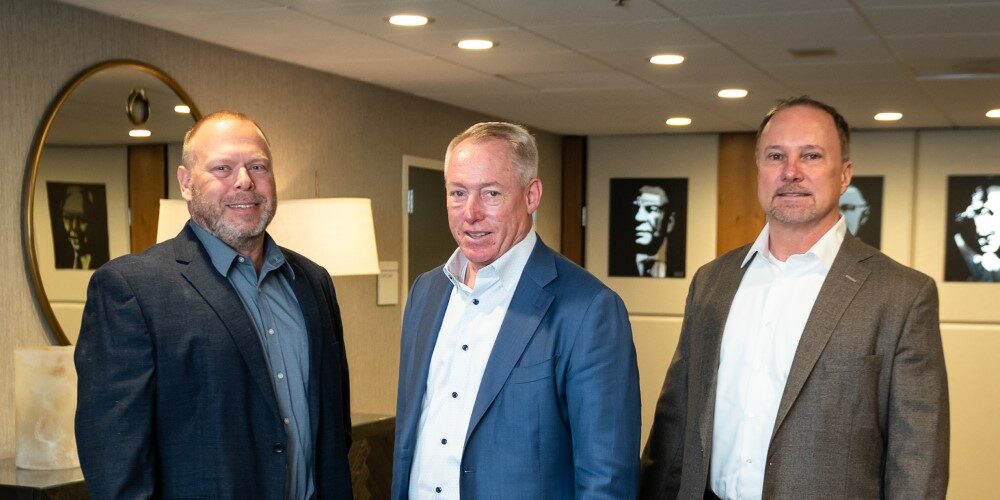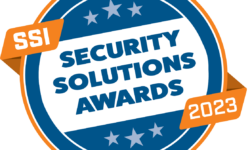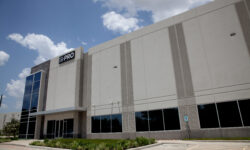2022 Commercial Dealer Executive Roundtable: Talking Tech, Talent & Tactics
SSI picked the brains of three of the security industry’s top integrators during the recent Honeywell Integrated Security conference. Discover the issues impacting their organizations and the highest priorities on their to-do lists.

(l-r) : Ronald Haught, John Nemerofsky and Carl Stark.
“A man’s got to know his limitations.” That famous 50-year-old quote by movie star Clint Eastwood’s Detective Harry Callahan (“Dirty Harry”) character offers wisdom to security dealers and integrators today, regardless of gender.
In a never more challenging business climate where those providers are recovering from a pandemic, contending with supply shortages, coping with soaring overhead costs, struggling to fill staffing vacancies and facing cutthroat competition — shrewd owners and operators realize they can’t go it all alone.
Fortunately, there’s no need to do so. Whether it’s looking internally to work smarter and more as a team or bring in specialized talent, or externally to network and collaborate with peers, attract investors, acquire other firms, generate investment capital or tightly partner with equipment and service vendors, many dealers and integrators are optimizing their companies’ growth and success by recognizing and embracing their “limitations.”
In the process, they are fully exposing their organizations to the practically unlimited security and business opportunities presented by today’s amazing technologies, products, systems and solutions in an environment of evermore customer interest and demand.
“We at times have to compete against one another or at times have our own integration challenges, but it is nice for us to come to a place like the Honeywell partner event to share what’s affecting your business. How are you doing? What are your best practices? It gives us an opportunity to spend time with peers and collectively work together,” Ronald Haught, CEO of Alarm Systems and Associated Technical Services, said during a break from the recent Honeywell Integrated Security (HIS) conference in Atlanta.
It is during that annual event that for many years Security Sales & Integration has been sitting down with leading operators to pick their brains about all manner of issues impacting their organizations and to decern the highest priorities on their to-do lists.
Joining Haught for SSI’s 2022 Commercial Dealer Executive Roundtable were SAGE Integration COO John Nemerofsky and Security 101 National Accounts Manager Carl Stark. Despite the numerous onerous obstacles set before them, these progressive providers are continuing to thrive because of their willingness to adapt to new offerings and business models.
“We are seeing the evolution of managed services, with deployment of Cloud solutions to customers,” says Nemerofsky. “The move to the Cloud and acceptance of a hybrid Cloud solution is creating opportunities to offer a means of managed services, not just as system administrator for their access control or video surveillance platform but another level of professional services. Remote diagnostics is one of the key ones, being the first line of defense for trouble-shooting and not having to roll a vehicle. That’s a win-win for everybody.”
Go ahead, make your day by paying close attention to the rest of what these industry leaders have to share.
Let’s jump right in on the supply chain. How’s it currently impacting your business and what is your outlook?
Ronald Haught: It has posed some challenges, but we’ve been able to leverage vendor relationships and partnerships with other integrators. When you get into the fire side of the house, that’s been pretty problematic. You just have to get creative; you’ve got to have realistic expectations that you’re expressing to your customers; it’s all about communication. If you overcommunicate that stymies a lot of problems in the end.
As for improvement into 2023, I’ll believe it when I see it. Everybody’s promising something today, but then it could be years for some. It’s going to be a challenge, probably until at least the end of Q1, and then you’re going to start to see some things loosen up and be a little bit more available. This situation is choking out a lot of integrators, and so that competition is going away. That’s going to create the availability to be able to get product because you’re going to have an influx with a smaller amount of integrator demand. Some of the smaller guys just can’t handle it, didn’t prepare, didn’t buy it, don’t have the relationships to leverage. That’s a big deal.
Carl Stark: As an integrator, obviously, supply chain is stalling projects. The backlog is very strong right now, very healthy, but things are being held up. For us it has been an advantage partnering with a large vendor like Honeywell that went out and got, even at a higher price, access to the chips that some other manufacturers didn’t. Everybody recognized that we’re in this together. Are there circumstances, whether it’s manufacturer or distributor, where you have to look at alternatives to complete a project? Sure. We’ve had tough decisions to make but we’ve made them collectively, communicating with existing vendors and end-user customers.
Some manufacturers charged through the pandemic and inflation concerns to make product when others didn’t. There are some lessons to be learned there. We’ll grow together as an industry. We are a small industry with personal relationships that will get us through it.
John Nemerofsky: We’ve taken advantage of this timeframe to go back to our clients to say, “You need to become better at forecasting or you’re not going to get your product delivered for a long, long time.” We can’t be a just-in-time integrator anymore, you need something 180 days from now you need to order now. It’s not five-to-seven-day delivery as it was pre-supply chain challenges. We benefited from our clients learning to forecast, which has made us a better partner to the manufacturers and distributors. The other thing we’ve had to do is increase inventory levels by as much as 25%.
When you look at the integration business, your cash sits in two spots, it’s in your inventory and in your receivables. Adding 25% to your inventory is taking 25% of your cash away. It’s challenging, but it’s a must if you’re going to continue to run service effectively and close service tickets on a first-time response. Ultimately, the supply chain issue is making the integrator stronger because now you need to understand min/max is on each part. How many am I keeping and as it gets toward minimum, I’ve got to reorder knowing there’s long lead times.
We’ve got clients that have ordered custom cards that won’t be available till September 2023. Waiting 18 months for cards is not a viable option, if a client that orders 10,000 cards every year, it’s not just to keep them on the shelf, they’re ordering to deploy them to their employees and contractors. There are challenges out there. Mercury hardware has become a huge challenge, getting HID readers and cards is a huge challenge. It’s about how you overcome these things and look at other technologies and fix it with a back-up plan or another manufacturer.
We’ve had clients move to mobile credentials because of the card shortage. We had a client 33 years with us that had standardized on Axis cameras but had to go to Bosch because Axis just wasn’t available. While we had had a standard at 7,000 sites, now we have had to mix and match technologies, which will be a challenge not just for the installation but for service down the road. That means more inventory on my trucks because I have two types of products up there instead of one. These are some of the impactful effects to the integrator.
Stark: Another issue we saw is you have some large end users that have specific products that they’ve standardized on. When it comes to cybersecurity, that’s the only approved product that can go on their network. When some manufacturers did not have any supply, it wasn’t as simple as making a business decision to select another manufacturer. The vetting process had to start all over again. If we’re going to test readers that has to be done by the IT department, those products have to be approved to go on that network. These end users have learned they can’t just have let’s say a single standard when it comes to the commodities of cameras of cards. They need to have alternative solutions.

Despite numerous onerous hurdles set before them, progressive providers are continuing to thrive because of their willingness to adapt to new business models. Clockwise from top left: Ronald Haught, Carl Stark, John Nemerofsky and SSI’s Scott Goldfine.
Once product flows more readily, how are you going manage the backload?
Nemerofsky: As integrators go, you’re usually burning 28% to 30% of your backlog on a monthly basis. Then sales refills that with new orders. Labor will have to be managed as products start to come in. We’ll be able to move faster and burn more backlog. As far as the workforce, we’re built a little differently than most as 80% of our employees are embedded in our clients’ accounts. It’s already a plan that there’s going to be people we need to service and install for that client.
I would say for the pure-play integrator workforce development is a huge issue for all of us where we find that next technician. It’s a challenge for the whole industry and that technician doesn’t want to stay a technician for a very long. They want to know what the next role is; trying to find that person who wants to run cable or install devices their whole life is tough. After doing it for a year they are already asking, “What’s next?”
Stark: We do have a pretty significant backlog. When we start to get product, it’s going to be a challenge. We’re going to definitely have to work. We don’t use a lot of subcontract labor historically, but we probably will turn to if necessary. If a construction schedule requires it to meet that deadline, we’re going to supplement with some specialty subcontract labor that might be an integrator, locksmith, cabling company.
Haught: We have some embedded folks. Our scenario is literally I’m in acquisition mode. I’m tired of trying to develop the talent. It’s getting harder and harder to find folks. The average length is two years or so before they jump careers now, so you’re always constantly fighting that battle. We literally are looking to go out and just purchase talent, buying companies we can bring into our fold and be better from what they were for their customers and what benefit they can bring to ours.
If you enjoyed this article and want to receive more valuable industry content like this, click here to sign up for our FREE digital newsletters!

Security Is Our Business, Too
For professionals who recommend, buy and install all types of electronic security equipment, a free subscription to Commercial Integrator + Security Sales & Integration is like having a consultant on call. You’ll find an ideal balance of technology and business coverage, with installation tips and techniques for products and updates on how to add to your bottom line.
A FREE subscription to the top resource for security and integration industry will prove to be invaluable.








